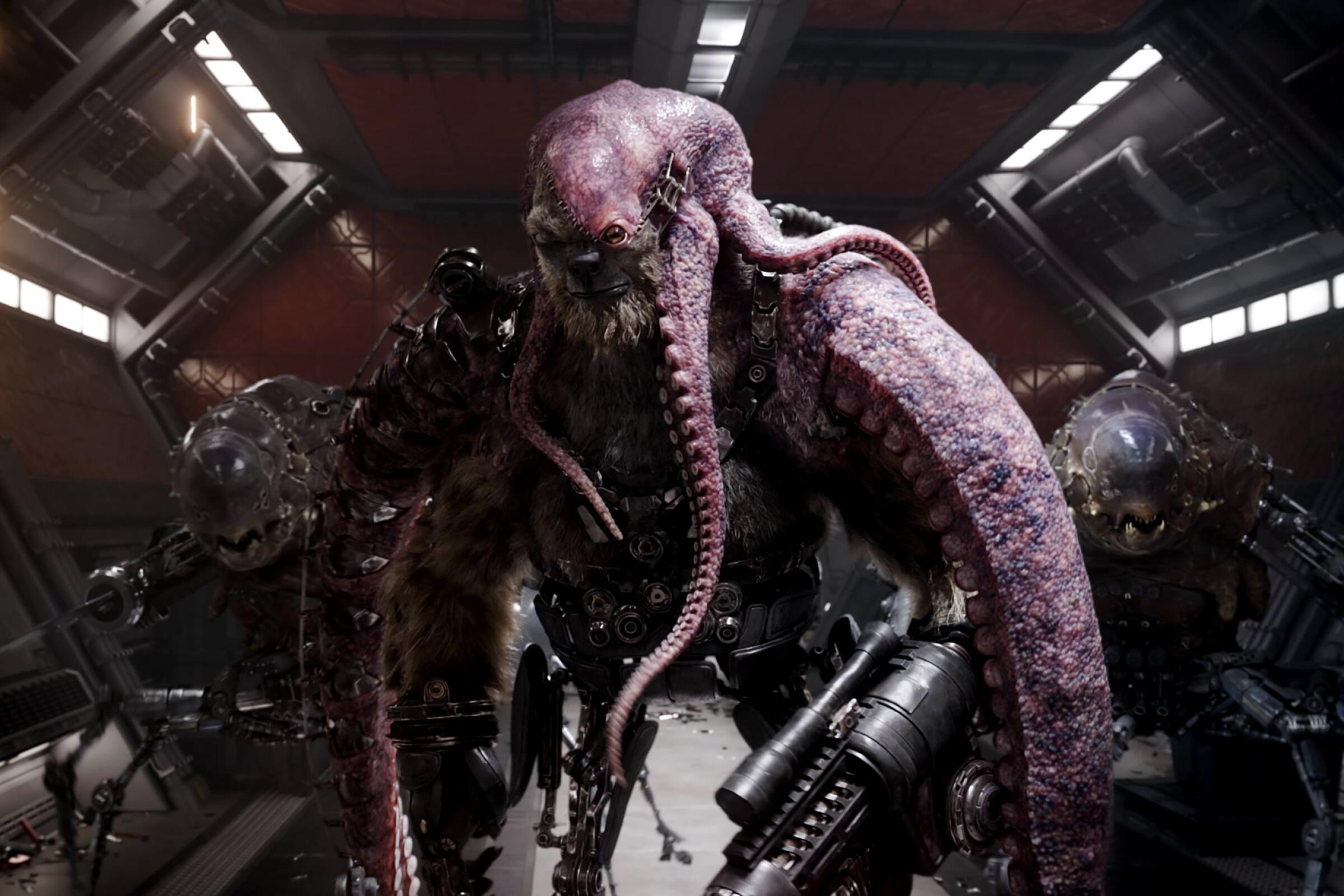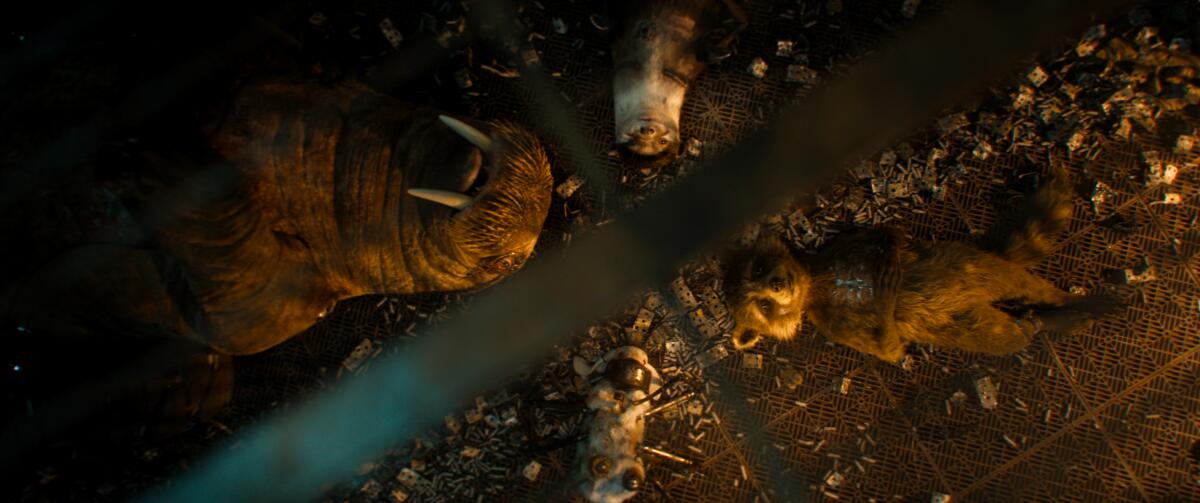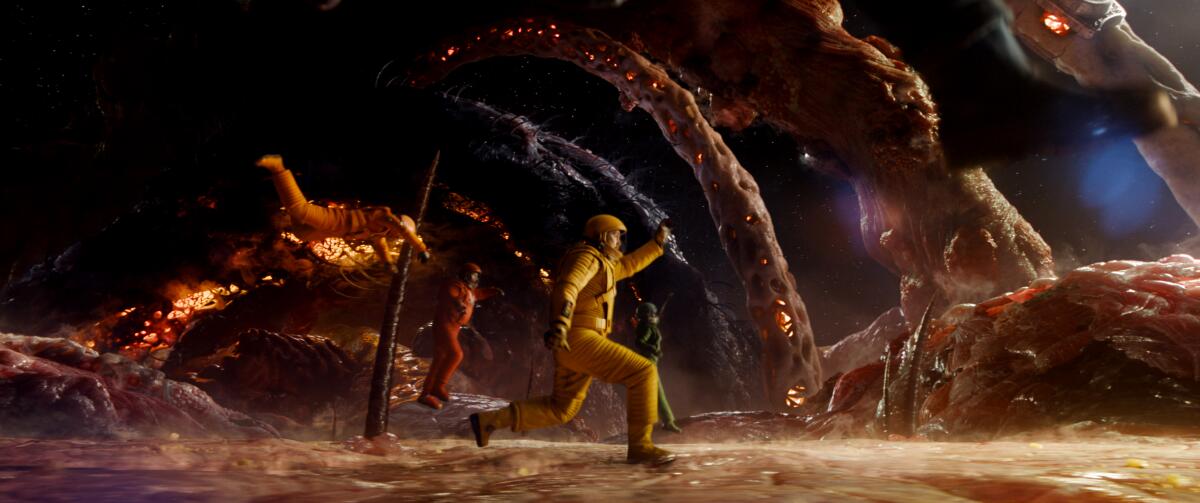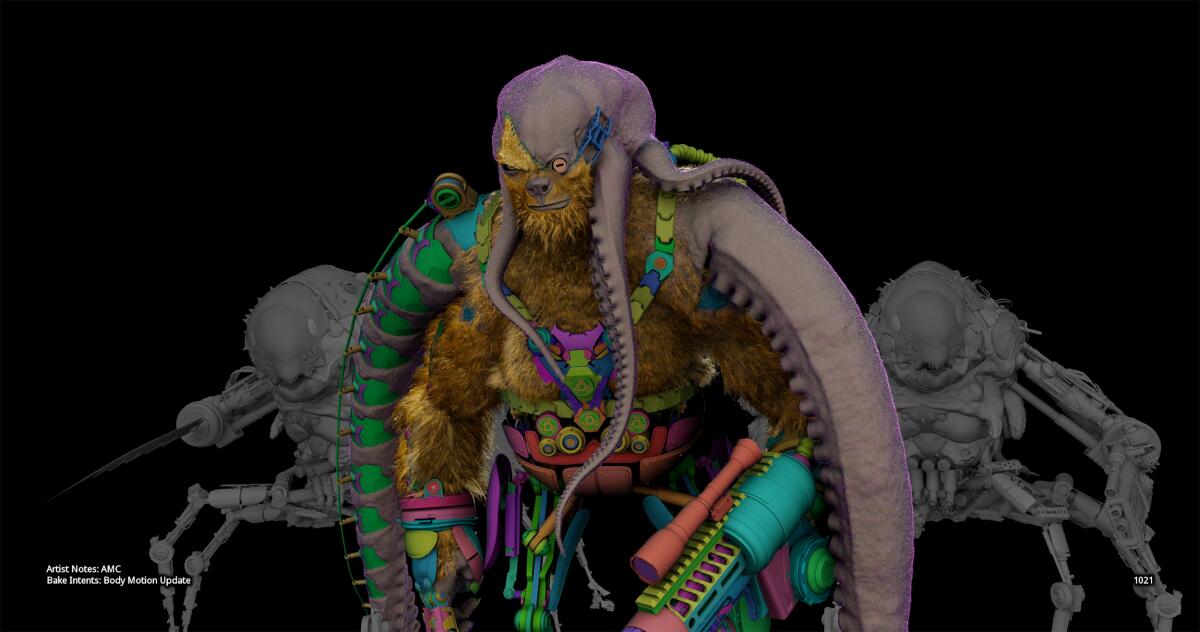Sign up for The Envelope
Get exclusive awards season news, in-depth interviews and columnist Glenn Whipp’s must-read analysis straight to your inbox.
You may occasionally receive promotional content from the Los Angeles Times.

Saying goodbye isn’t easy. And for director James Gunn, “Guardians of the Galaxy Vol. 3,” a film he almost didn’t make after controversial social media posts resurfaced, became his swan song in more ways than one as he left Disney following the production to become the head of DC Studios with Peter Safran.
The third installment in the series that sees a collection of intergalactic former mercenaries, including a talking raccoon called Rocket, and Groot, the walking, talking (limited though it may be) tree, fight evil from around the Marvel Cinematic Universe, pivots from Peter Quill (Chris Pratt) to the origin story of Rocket (voiced by Bradley Cooper) with all the trimmings we’ve grown to love from the franchise: thrilling action sequences, laugh-out-loud humor and an epic cosmic adventure. The villain now is a species-creating and -destroying sociopath named the High Evolutionary (Chukwudi Iwuji), who for years has experimented on innocent animals, including Rocket, and will stop at nothing to get him back.
Leading the visual effects charge was Stephane Ceretti, who was fully aware of the stakes. “There was a lot of joy working with James and knowing it was the last one. It made it very special for everyone on the film, and we were happy to give these characters a proper sendoff.” To do so required multiple VFX vendors and hundreds of artists working on the more than 3,000 visual effects shots in the film.
Below, Ceretti shares the emotionally penetrating details that went into making Rocket’s first friendships, a visually stunning planet made of meat and a high-octane fight to last the ages.
Writer-director James Gunn concludes his trilogy — and his Marvel stint — with “Guardians of the Galaxy Vol. 3,” an enjoyably eccentric caper and an especially harrowing origin story.
Capturing a Furry Friendship
The emotive backbone of the story lies in Rocket’s adolescence where the raccoon is experimented on by the High Evolutionary in order to create a utopian society. Through a series of flashbacks (while Rocket has fallen into a coma in the modern-day world) we see his early brilliance, solving “beta-microseminoproteins” theories and his blossoming friendship with Lylla (Linda Cardellini), Teefs (Asim Chaudhry) and Floor (Mikaela Hoover) from inside their cages.

To capture the heartwarming connection, each actor wore performance capture-suits for a two-day makeshift virtual production shoot (standing in for Rocket was Sean Gunn, the director’s brother). “Psychologically, it was good to start off shooting these sequences, because they were such a core to the film,” Ceretti says. “The first two days, we filmed 15 minutes of the movie, which is incredible when you think about it.” The footage was then cut together by editor Fred Raskin before being sent off to Framestore for the heavy lifting.
Though the actors wore mo-cap suits, every piece of fur and expressions of the four friends was created using animation, with the team referencing things like how real baby raccoons move and play. The early footage was treated as a scene-building guide that kept being refined for the final shots. Along with the cage scenes, the white corridor scene when Rocket meets Lylla in the afterlife was also shot during those first two days of production — the aesthetics of which were made to look like an ethereal environment using gradients of white light.
“Just the actors in their gray suits, it was already so emotional,” admits Ceretti. “It is a perfect example of how the actors are essential for us. We would have spent months and months trying to figure out what to do if we didn’t have the actors acting for us. There is no world in which we do this without good actors.”

Creating a Meat-like Planetoid
To save Rocket, the Guardians must override a kill switch implanted inside him with a pass key that’s located on the Orgoscope, a bio-formed space station composed of bones, flesh and fat. “The difficult part is that it’s not a macro world. It’s a big planetoid, so we had to figure out how to convey the look of this gigantic [structure] made of meat from far away and also when we dive onto the surface,” Ceretti says.
Finding the balance between scale and detail was crucial, especially when the Guardians dock on the Orgoscope‘s rubbery exterior. “There’s this squishy, tactile feel to the world. So when they land you see them kind of bouncing,” Ceretti says. “Every time they walk, gasses get released by the meat. It’s really weird and disgusting, but it’s very James Gunn.”
The team at Sony Pictures Imageworks went through several iterations to find the “1970s comic book vibe” the director wanted for the exterior. Inside, a maze of white bonelike structures form the levels and rooms to OrgoCorp headquarters and a sea of pink plants made of meat pepper the walkways. A practical interior set was built that included a floor, some of the white structures and plants, but it was mostly digitally replaced. For the fight scene between the Guardians and OrgoCorp sentries as they attempt to leave with the pass key, practical wire work was mixed with CG action. “All of it was quite complicated but fun,” notes Ceretti. “Conceptually, it was one of the hardest sequences of the film from a look point of view.”

Designing a Final Battle
After saving Rocket’s life and freeing Mantis (Pom Klementieff), Drax (Dave Bautista) and Nebula (Karen Gillan) from the High Revolutionary’s ship, the Guardians face a moral dilemma: “get the hell out of there” or free the children and animals that remain trapped on board. Their conundrum is answered when Rocket, in a character-defining moment, says “I’m done runnin’.” Then, in all of its fiery slow-motion glory, the heroes turn toward the carnage to the tune of “No Sleep Till Brooklyn” by Beastie Boys. Awaiting them is an army of guards and creepy biomechanical creatures who, of course, the Guardians pulverize in exhilarating fashion.
The challenge for Weta FX was delivering action as a seamless single shot (commonly known as a oner) that clocked in at 2½ minutes. Initial discussions focused on the timing of stunts, stitching points [where the segments can be edited together invisibly] and choreography that wanted to match to the rhythm of the music. Adding to the complexity, set photography was shot at 120 frames per second so that key moments — like Quill rolling to dodge a swinging sword or a punch that knocks Nebula’s head off her spine — could be slowed down or sped up. It meant visual effects had to do a lot more rotoscoping, match-moves and camera tracking, but in doing so, it gave the team the ability to tightly control character performance.
Over a dozen complex stitches propelled the one-take aesthetic that transitioned between principal and digital photography. “We tried to avoid the trap of every time we have a stitch we have a monster going in front of the frame. So it becomes more complicated, because there’s nowhere to hide,” says Ceretti. For example, in one instance, the camera follows Rocket as he runs down Groot’s outstretched arm before he spins 360 degrees in the air and blasts a creature dead. The camera then tracks back toward Groot by going through a bullet wound on one of the creatures. Ceretti says, “It’s an iconic moment for the group, showing one last time how good they are when they fight together as a family.”
Sign up for The Envelope
Get exclusive awards season news, in-depth interviews and columnist Glenn Whipp’s must-read analysis straight to your inbox.
You may occasionally receive promotional content from the Los Angeles Times.